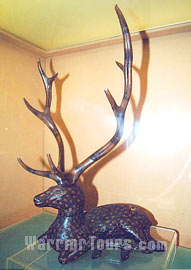Lacquer Ware

Raw lacquer is the natural sap stripped from the sumac. It has a high resistance to humidity, high temperature and corrosion and can be blended into different colors. As an important innovation in the chemical technology and art of ancient China, lacquer wares are art and craft works made by painting raw lacquer on the surface of various daily utensils.
Originally, lacquer wares were just some wood and bamboo objects painted with lacquer on the surface. Later, with the development of the craft, many other lacquer wares appeared, such as colored drawing lacquer, painted gold lacquer and fill-in lacquer, carved lacquer - painting lacquer on in a thick layer, and then carving patterns into it, and lacquer inlaid with gold, silver, bronze, jade, gem or other decorations.
The craft of making lacquer wares is complicated. The general process is to make molds with bamboo, bronze, ceramics or other materials, or first carving directly with solidified lacquer, and then decorating the surface through various techniques. However, the actual operation does need advanced skills in order to produce fine craftwork.
![]() History
History
According to the red lacquer bowls and tubes of the Hemudu Culture found in Yuyao, Zhejiang Province, lacquer wares have been used in China for nearly ten thousand years. From the first dynasty – Xia (21st – 16th century BC) to the Warring States Period, the number and category of lacquer wares continuously increased. Especially in the Warring States Period, lacquer ware was one of the main economic resources of the country, and there were specific officials in charge of its production.
During the Han Dynasty (206 BC – 220 AD), lacquer ware at its best was widely used as daily utensils. Then black and red were the major colors, and the categories were extended to boxes, earrings, rulers, veils, chessboards, stools and so on. Besides, new crafting techniques were also developed, including multicolor, needle-incising, gold leaf adhering, hawksbill adhering, chasing, and embossing. Thereafter, many other delicate lacquer wares were created. Lacquer wares with silver and golden decorations of the Tang Dynasty (618 - 907), plain lacquer wares of the Song Dynasty (960 - 1279), and carved lacquer ware of the Yuan Dynasty (1271 - 1368) are the most noted categories.
The Ming (1368 - 1644) and Qing (1644 - 1911) Dynasties were a golden period in the development of China lacquer ware. With the lacquer chased with multi-precious objects of the Ming Dynasty and bodiless lacquer ware of the Qing Dynasty as the representatives, lacquer craft began to combine with architecture, furniture and displays, from the practical to display and decoration.
![]() Local Lacquer Wares in China
Local Lacquer Wares in China
Bodiless Lacquer Ware of Fujian Province - the representative objects are tea wares, which emerged in the Qing Dynasty. First, molds are made with wood or clay according to the design of the tea wares, and then painted with lacquer several times. Finally removing the molds, a set of simple and elegant tea wares will come out through re-painting, polishing, and decorating time and again. A set of tea ware usually consists of a teapot and four teacups held in a round or quadrate tea tray, with the same black, dark green, yellowish-brown or brownish-red color.
Carved Lacquer Ware of Beijing - originating in Sichuan and Yunnan Provinces in the Tang Dynasty, Beijing Carved Lacquer together with Jingdezhen Porcelain and Xiang Embroidery are regarded as the "three treasures" of traditional Chinese handicrafts. It was so named because of the main working procedure is carving, and the main material is lacquer. In Beijing carved lacquer ware, lacquer is painted on the wooden or bronze molds time after time until until it is five to eight mm thick, and then carving with patterns of landscape, figures of people, flowers, birds, and animals. The process is very complicated, there are altogether over ten procedures from the design to the final polish. Nowadays, the carving skills are developed from shallow carving to relief carving, hollow carving, and circular carving, which make the lacquer wares stereoscopic. With the recent appearance of carved lacquer murals, Beijing carved lacquer wares are used more and more as decorations.
Inlaid Lacquer Ware of Yangzhou - inserting with emerald, ivory, agate, jade, lotus stone, crystal, silver and golden sheet, these lacquer wares are visually gorgeous, elegant and noble. Besides mother-of-pearl lacquer produced in Yangzhou is also well-known in China. Most of the lacquer wares produced here are dining tools, stationery items, and other daily utensils.
Lacquer Ware of Huizhou - produced in Huizhou District of Huangshan City, Anhui Province. It is also inlaid lacquer ware famous in the Song Dynasty, enjoying fame as 'Song Inlay'. With bamboo, wood, silver, gold and tin with the mold materials, it is painted with colorful lacquer layer upon layer. Then, insert colored clamshell, silver and golden filigrees, and colorful stones in it. Through polishing and other procedures, it will present brilliant and dazzling patterns finally.

